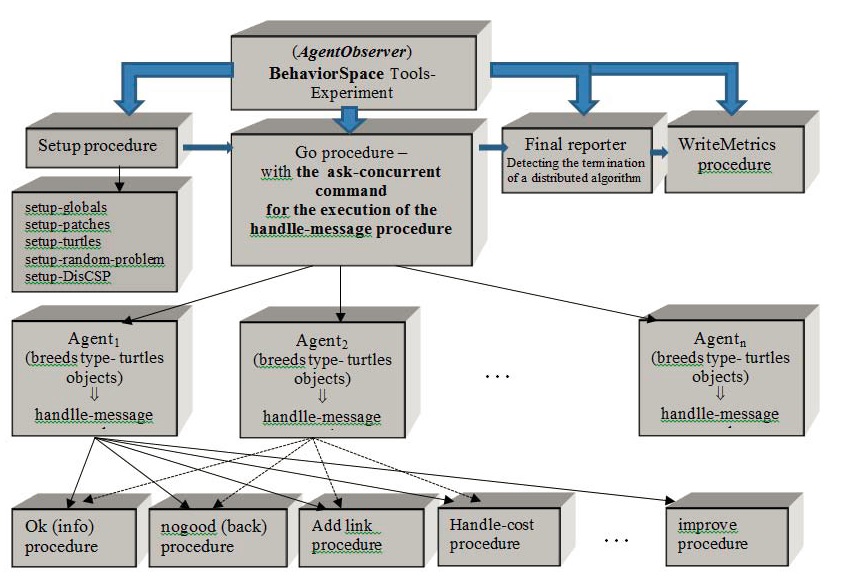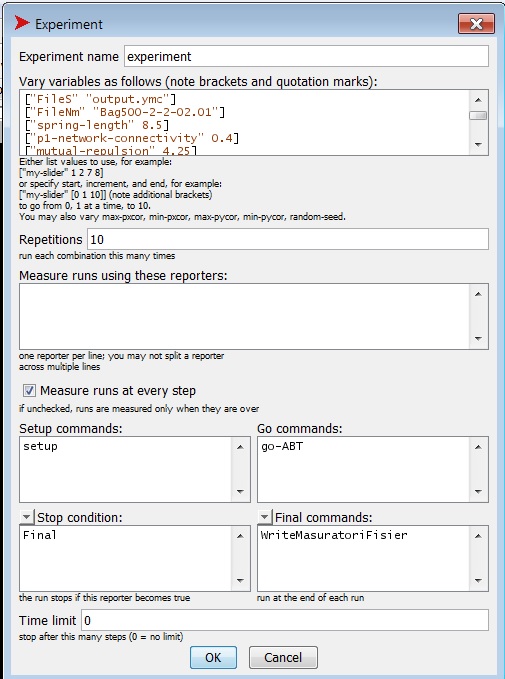The asynchronous search techniques can be remarked by the existence of a very large number of elements that can be introduced, without affecting the completeness of the algorithm. For example, processing the message in packets or individual, storage or not of the nogood messages, message filtering, nogood learning and storing them for each value. Thus, a correct evaluation assumes a large number of runs, with different data sets. We present an open-source solution for implementation and evaluation of the asynchronous search techniques in NetLogo, for a great number of agents, model that can be run on a cluster of computers. In this page we will present a methodology to run the proposed NetLogo models in a cluster computing environment or on a single machine [1][2]. We utilize
the Java API of NetLogo as well as LoadLeveler. LoadLeveler is a job scheduler
written by IBM, to control scheduling of batch jobs. This solution is not restricted
to operate only in this configuration, it can be used on any cluster with
Java support and it operates with other job schedulers as well (such as Condor).
Such a solution will allow running a large number of agents (nodes, variables, The methodology proposed in the previous pages that uses the GUI interface will run on a single computer. In this paragraph we will present a new solution, without GUI, that can run on a single computer or on a cluster. The proposed approach uses the NetLogo model presented previously, runnable without the GUI, with many modifications. In order to run the model in that manner is used a tool named BehaviorSpace, existent in NetLogo. BehaviorSpace is a software tool integrated with NetLogo that allows you to perform experiments with models in the “headless” mode, that is, from the command line.without any graphical user interface (GUI). BehaviorSpace runs a model many times, systematically varying the model’s settings and recording the results of each model’s run. Using this tool we develop an experiment that can be runned on a single computer (with a small number of agents) or, in the headless mode on a cluster (with a large number of agents). The steps necessary for the implementation of a multiagent system are as follows:
netlogo-headless.sh
|
|
[1]. Ionel Muscalagiu, H.E. Popa, Jose Vidal. Large Scale Multi-Agent-Based Simulation using NetLogo for implementation and evaluation of the distributed constraints. In proceedings of IJCAI – DCR 2013 (23rd International Joint Conference on Artificial Intelligence - Workshop on Distributed Constraint Reasoning ), Beijing, August 2013. Available: http://www.cs.nmsu.edu/~wyeoh/DCR2013/index.html.
[2]. Ionel Muscalagiu, H.E. Popa, Jose Vidal. Clustered Computing with NetLogo for the evaluation of asynchronous search techniques. In proceedings of 12th IEEE International Conference on Intelligent Software Methodologies, Tools and Techniques (SOMET 2013), pag. 115-120, September, Budapest 2013.
[3]. InfraGRID Cluster. Available:http://hpc.uvt.ro/infrastructure/infragrid/.


